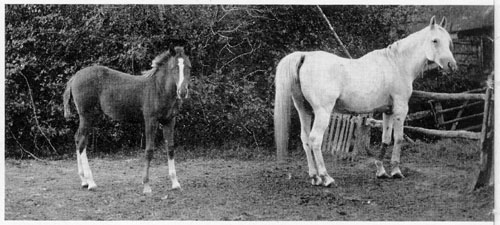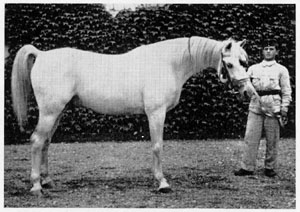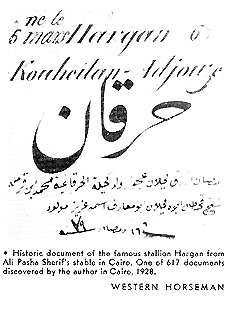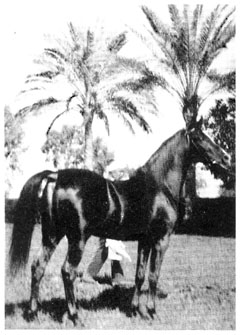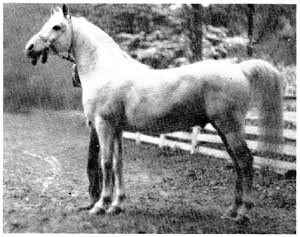| IT APPEARED with regularity that many offspring
of imported "Arabian" stallions in Europe deteriorated quickly
or were born without Arabian characteristics from otherwise typical Arabian
mares. The change of climate, feed and water were blamed for it, even the
surroundings or "atmosphere" which were supposed to have influenced
the "psyche" or soul of the poor brood mare -- but the real cause
was not discovered until the end of the last century when representatives
of the famous historical stud farms of Europe went to Egypt to attend the
dispersal sale of Ali Pasha Sherif stud farm in Cairo on March 26, 1897.
ALI PASHA SHERIF, an Egyptian, raised in the
French Army, later high official under Muhammad (Medhemet) Ali and President
of the Legislative Council of the Government, was the outstanding breeder
of Arabian horses of the last century. Horse breeding in Egypt had been
at a low during the rule of the Turks and Muhammad Ali regime (1805-1848).
Their reckless despotism and "personal" wars in Arabia and against
the Greeks, Nubians and his own Sultan (Turkey) had ruined the country
of Egypt and had discouraged the horse breeders (whose fine animals Muhammad
Ali had seized for military use).
MUHAMMAD ALI of Egypt, the tyrant, has been
romanticized too much. Historical fact is that the few good horses which
the Mamelukes had left in Egypt, were picked up by papers of Europe in
1839 and announced that "Muhammad Ali of Egypt has dealt a death
blow to Arabian horse breeding in his own country. Not one private stud
farm has survived his purge, the Arabian horse has ceased to exist in Egypt
and only new importations from Arabia can save the situation, as Egypt
is still an ideal country for raising horses."
THIS MUHAMMAD ALI was forced to do something
about it, as his finances came from political sources in Europe and important
European rulers and their diplomats were great horse fanciers and connoisseurs
who had been aroused by these reports in the European press. Muhammad Ali
hastened to establish a stud farm of Arabian horses near Cairo which, however
served only as an "illustrious" background for his oriental palace
and the splendor of his court.
IN ARABIA itself Muhammad Ali's son Ibrahim
Pasha wrought undescribable damage to horse breeding when he conquered
the Inner-Arabian provinces, leaving nothing but ruins and fields strewn
with dead behind him. Famine and disease ravaged the settled districts
and spread into many parts of the desert, destroying man and beast -- "plundering"
the tribes of many of their finest horses.
BUT IN this time of despair rose a savior of
the Arabian horse: Abbas Pasha Al-Auwal, Viceroy of Egypt (1854-1859),
who imported a great number of the classic-antique type of Arabians from
the desert tribes. His emissaries went on long and dangerous missions to
the Bedouins and brought choice specimens to Egypt - animals of the pure
Saglawi or Kuhaylan strains. Some of these horses were bought for fabulous
sums. Five to eight thousand dollars were only average prices; one crippled
mare (but of an almost extinct strain) had to be brought across the desert
of Arabia in a cart. Abbas Pasha was really collecting "antiques,"
some cynics even say he recovered old ruins -- but lo! what foals he raised
out of these despised "cripples." It was the blood he was after.
Abbas Pasha did not care in what condition they arrived in Aat his stud
farm in Egypt. Every authority on Arabian horses agrees to this day that
finer horses have never come out of Arabia than those which Abbas Pasha
acquired. Their blood is still to be found in our stud books of Arabian
horses in America.
AFTER THE death of Abbas Pasha and at the disposal
sale of his celebrated horses by his son Al-Hami in 1890, Ali Pasha Sherif
acquired the greater part of these priceless animals.
THROUGHOUT THIRTY-SEVEN years (until his death
in 1897) Ali Pasha Sherif retained this classic-antique type of Bedouin
horses and their descendants from Abbas Pasha stock and by some new additions
of his own importations from Desert Arabia.
I HAVE MADE a special study of these Abbas Pasha
Al-Auwal and Ali Pasha Sherif horses, their pedigrees and origin from the
desert and I can faithfully say the "Secret" of the exquisite
beauty, style and perfection for which these horses are renowned in our
days lies within their blood - the pure blood of their classic-type strains.
FAITHFULLY Ali Pasha Sherif bred (1860 to 1897)
within the same strain or within related strains of the Kuhaylan and Seglawi
producing those priceless and perfect animals which artists and breeders
from all over Europe came to admire -- or if they were fortunate -- to
acquire -- a great favor indeed, which Ali Pasha Sherif bestowed upon a
few only.
THE AUCTION sale of Ali Pasha Sherif's Arabian
horses in Cairo, March 26, 1897, will stand out forever in the history
of Arabian horse breeding. At one stroke it brought more "antique"
type Arabian horses into the hands of European breeders than before or
since. The axiom still holds good today the more Ali Pasha Sherif blood-lines
appear in any of our Arabian horses in America, Europe or Egypt, the more
outstanding such an individual in regard to Arabian characteristics. If
bred within classic types (Kuhaylan and Saqlawi or their related strains)
these Ali Pasha Sherif horses have not even to our day deteriorated --
no matter where they have been bred (Egypt, England, Poland, America) even
if outside (new) blood has been added -- as long as this additional blood
was of the same strain or related strains (no Mu'niqi or Mu'niqi related
blood). For example the Blunts added to their Ali Pasha Sherif mares blood
from their own sires which they had brought from Arabia (or vice-versa
-- mares of their own selection from Desert Arabia were bred to Ali Pasha
Sherif mares. In every case where no Mu'niqi (or Mu'niqi related) blood
was added the classic type remained and neither climate, feed, water, surrounding
or "atmosphere" caused a change. I only want to mention a few,
but they are the best names in our stud books -- and never had a drop of
Mu'niqi blood: Abu Zeyd, Ibn Mahruss, Daoud, Rasin, Ridaa, Nasik, Rasima,
Mesaoud, Rijm, Nasr(I), Hamida, Mahroussa, Nijma, Rizvan, Nasra, Risala,
Rijma, Kafifan (Poland), Kibla, Rodan, Serra, Gulnare, Naseem, Harb, Naziri,
Seyal, Nashisha ($30,000), Shahwan, Wazir, Yashmak, Radwan, etc. Peers
among Arabian horses -- every one acclaimed in books on horse breeding
for their Arabian type and characteristics and every one rich in Ali Pasha
Sherif and Abbas Pasha blood lines of the classic type.
|
